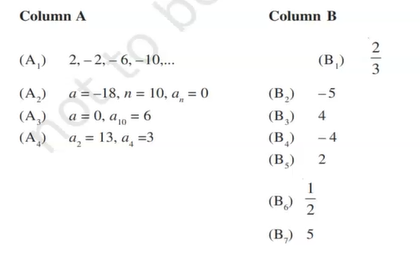Complete Solutions to Short Answer Type Questions of chapter ARITHMETIC PROGRESSIONS of Class 10 book with complete answers and questions
| Class 10 | MATHS |
| Chapter | ARITHMETIC PROGRESSIONS |
| NCERT EXEMPLAR | Short Answer Type Questions |
| Number Of Questions | 35 |
| Academic Year | 2023-24 |
Match the AP's given in column A with suitable common differences given in column B.
 03:07View Solution
03:07View SolutionVerify that each of the following is an AP and then write its next three terms.
(i) `0, (1)/(4),(1)/(2),(3)/(4), … " " ` (ii) `5,(14)/(3),(13)/(3),4, …`
(iii) `sqrt(3),2sqrt(3),3sqrt(3), … " " ` (iv) `a+b,(a+1)+b,(a+1)+(b+1), ...`
(v) `a,2a+1,3a+2,4a+3, …`09:04View SolutionWrite the first three terms of the AP's, when a and d are as given below
(i) `a=(1)/(2), d= -(1)/(6) " " `
(ii) `a= -5, d= -3`
01:43View SolutionFind a, b and c such that the following numbers are in AP, a, 7, b, 23 and c.
02:40View SolutionDetermine the AP whose fifth term is 19 and the difference of the eighth term from the thirteenth term is 20.
03:04View SolutionThe 26th, 11th and the last terms of an AP are, 0, 3 and `-(1)/(5)`, respectively. Find the common difference and the number of terms.
03:47View SolutionThe sum of the 5th and the 7th terms of an AP is 52 and the 10th term is 46. Find the AP.
03:43View SolutionFind the 20th term of the AP whose 7th term is 24 less than the 11th term, first term being 12.
02:36View SolutionIf the 9th term of an AP is zero, then prove that its 29th term is twice its 19th term.
02:25View SolutionFind whether 55 is a term of the AP 7, 10, 13, … or not. If yes, find which term it is.
01:58View SolutionDetermine `k`, so that `k^(2)+4k+8, 2k^(2)+3k+6` and `3k^(2)+4k+4` are three consecutive terms of an AP.
03:39View SolutionSplit `207` into three parts such that these are in A.P. and the product of the two smaller parts is `4623`.
03:53View SolutionThe angles of a triangle are in A.P. The greatest angle is twice the least. Find all the angles
03:43View SolutionIf the `n`th terms of the two AP's 9, 7, 5, … and 24, 21, 18, … are the same, then find the value of `n`. Also, that term.
03:56View SolutionIf sum of the 3rd and the 8th terms of an AP is `7` and the sum of the 7th and 14th terms is `-3`, then find the 10th term.
04:05View SolutionFind the 12th term from the end of the AP
`-2, -4, -6, …, -100.`02:10View SolutionWhich term of the AP `53`, `48`, `43`, … is the first negative term ?
04:43View SolutionHow many numbers lie between `10` and `300`, which divided by `4` leave a remainder `3``?`
03:06View SolutionFind the sum of two middle terms of the AP `-4/3,-1,-2/3,-1/3,...,4(1/3)`
05:03View SolutionThe first term of an AP is `-``5` and the last term is `45`. If the sum of the terms of the AP is `120`, then find the number of terms and the common difference.
02:47View SolutionFind the sum
(i) `1+(-2)+(-5)+(-8)+ … +(-236)`
(ii) `(4-(1)/(n))+(4-(2)/(n))+(4-(3)/(n))+ …` upto `n` terms.
(iii) `(a-b)/(a+b)+(3a-2b)/(a+b)+(5a-3b)/(a+b)+ … ` to 11 terms.10:31View SolutionWhich term of the AP `-2,-7,-12, …` will be `-77` ? Find the sum of this AP upto the term `-77`.
04:31View SolutionIf `a_(n)=3-4n`, then show that `a_(1),a_(2),a_(3), …` form an AP. Also, find `S_(20)`.
04:35View SolutionIn an AP, If `S_(n)=n(4n+1),` then find the AP.
03:16View SolutionIn an AP, If `S_(n)=3n^(2)+5n` and `a_(k)=164,` then find the value of k.
03:26View SolutionIf `S_(n)` denotes the sum of first `n` terms of an AP, then prove that `S_(12)=3(S_(8)-S_(4)).`
04:26View SolutionFind the sum of first `17` terms of an AP whose 4th and 9th terms are `-15` and `-30`, respectively.
04:26View SolutionIf sum of first 6 terms of an AP is 36 and that of the first 16 terms is 256 , then find the sum of first 10 terms.
04:58View SolutionFind the sum of all the `11` terms of an AP whose middle most term is `30`.
03:49View SolutionFind the sum of last ten terms of the AP `8`, `10`, `12`, …, `126`.
03:23View SolutionFind the sum of first seven numbers which are multiples of `2` as well as of `9`.
02:26View SolutionHow many terms of the AP `-15, -13, -11, … ` are needed to make the sum `-55` ?
04:21View SolutionThe sum of the first n terms of an AP whose first term is `8` and the common difference is `20` is equal to the sum of first `2n` terms of another AP whose first term is `-30` and the common difference is `8`. Find `n`.
04:41View SolutionKanika was given her pocket money on Jan `1st` , `2008`. She puts `Rs.` `1` on day `1`, `Rs.` `2` on day `2`, `Rs.` `3` on day `3` and continued doing so till the end of the month, from this money into her piggy bank she also spent `Rs.` `204` of her pocket money, and found that at the end of the month she still had `Rs.` `100` with her. How much was her pocket money for the month ?
03:58View SolutionYasmeen saves `Rs.` `32` during the first month, `Rs.` `36` in the second month and `Rs.` `40` in the third month. If she continues to save in this manner, in how many months will she save `Rs.` `2000` ?
04:57View Solution
Short Answer Type Questions questions and complete solutions for chapter ARITHMETIC PROGRESSIONS of NCERT MATHS (ENGLISH) of Class 10
